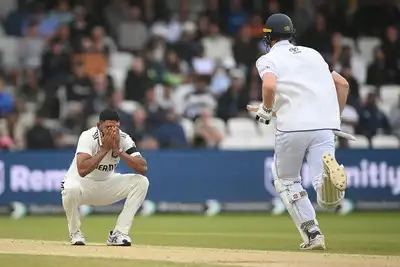India faces a critical juncture after a devastating loss in the first Test against England at Headingley. The defeat raises questions about team composition and strategy as they head to Birmingham for the second Test.

Despite a strong batting performance, India couldn't defend their total, marking a historic first in Test cricket. They became the first team to lose a Test match after scoring five centuries. The bowling attack is now under scrutiny after failing to capitalize on a substantial 835 runs scored over two innings.
Jasprit Bumrah's efforts in the first innings, where he took 5-83, were commendable, but he lacked sufficient support. While English batters played him cautiously in the second innings, Mohammed Siraj struggled to maintain consistent pressure, and Prasidh Krishna, despite taking five wickets, conceded runs at a high rate. Ravindra Jadeja, the lone spin option, couldn't replicate his usual impact on a pitch that didn't offer significant spin.
Gautam Gambhir, the coach, hinted that sweeping changes to the bowling lineup are unlikely for the upcoming Test. He acknowledged Siraj's experience and praised Prasidh Krishna's potential.
"Barring Bumrah and Siraj, we don’t have too much experience in the attack. Prasidh bowled very well and got us important wickets. He brings something different to the table with the bounce that he generates and has the ingredients of becoming a very good Test bowler,” Gambhir said.
He emphasized the need to give the bowlers time to develop, drawing a comparison to past teams with more experienced pace attacks. Gambhir stressed the importance of building a strong fast-bowler battery for the future.
While the top pacers are expected to be retained, Shardul Thakur's place in the team is uncertain after a quiet performance with both bat and ball. Despite Gambhir's appreciation for Shardul's wickets, the need to bolster the bowling attack remains.
“I agree that even if you score 1000 runs, a victory is not guaranteed. To win, you need to take 20 wickets, but we will have to see the conditions (at Edgbaston) before taking a call,” Gambhir said.
A strategic move could involve including Kuldeep Yadav in the second Test. His impressive performance against England in 2023-24, where he took 19 wickets, highlights his potential impact. Given that some English batsmen showed vulnerability against spin in the first Test, Kuldeep's wrist spin could be a valuable asset.
Kuldeep's inclusion would provide a genuine wicket-taking option, which India lacked in Headingley. However, this wouldn't necessarily mean replacing Ravindra Jadeja, who continues to have strong support within the team.
Captain Shubman Gill expressed satisfaction with Jadeja's performance, and Gambhir echoed this sentiment. Jadeja's ability to control the run rate and bowl economically remains valuable. The decision then hinges on whether the team is comfortable playing with just three pacers.
If the team opts for a fourth pace option alongside two spinners, Karun Nair, who had a quiet outing in the first Test, could make way for Nitish Reddy, a batting all-rounder. Reddy's performances in Australia, including a century at the MCG, make him a compelling option.
India's late-order collapses, where they lost 13 wickets for 72 runs, significantly impacted the match. Gambhir acknowledged that scoring an additional 150-200 runs in the first innings would have made a difference.
"It’s not that they are not applying themselves, they are trying. Yes, those extra runs would have been crucial, but I don’t want to blame 9, 10 and 11 for not getting a lot of runs," Gambhir said. He emphasized that the top order had done enough.
The coach has a valid point, as scores of 471 and 364 should ideally be sufficient to secure a Test victory in England.
The upcoming Test will reveal whether India decides to take the bold step of fielding five specialist bowlers to capitalize on the good form of their top-order batsmen.
Newer articles
Older articles
 Rishabh Pant: Greg Chappell Hails India Star as Cricket Revolutionary
Rishabh Pant: Greg Chappell Hails India Star as Cricket Revolutionary
 Gavaskar Calls for Kuldeep Yadav's Inclusion in Second Test Amid Bumrah Fitness Concerns
Gavaskar Calls for Kuldeep Yadav's Inclusion in Second Test Amid Bumrah Fitness Concerns
 Google Maps to Boost Navigation Accuracy with Fused Orientation Provider API
Google Maps to Boost Navigation Accuracy with Fused Orientation Provider API
 Global Vaccination Rates Plunge: Millions of Children Now Vulnerable to Preventable Diseases
Global Vaccination Rates Plunge: Millions of Children Now Vulnerable to Preventable Diseases
 Skin Cancer Alert: How to Identify Suspicious Moles and Early Warning Signs
Skin Cancer Alert: How to Identify Suspicious Moles and Early Warning Signs
 Suryakumar Yadav's Sports Hernia: Understanding the Injury, Recovery, and Risk Factors for Athletes
Suryakumar Yadav's Sports Hernia: Understanding the Injury, Recovery, and Risk Factors for Athletes
 Ashada Gupt Navratri 2025: Unveiling the Hidden Significance, Dates, and Rituals of the Monsoon Festival
Ashada Gupt Navratri 2025: Unveiling the Hidden Significance, Dates, and Rituals of the Monsoon Festival
 Vijay Sethupathi Apologizes Amid Controversy Over Son Surya's Debut Film 'Phoenix' and Alleged Video Removal Pressure
Vijay Sethupathi Apologizes Amid Controversy Over Son Surya's Debut Film 'Phoenix' and Alleged Video Removal Pressure
 TSMC Regains Top 10 Global Company Ranking Amid AI Chip Demand Surge
TSMC Regains Top 10 Global Company Ranking Amid AI Chip Demand Surge
 IRCTC Launches AI Chatbot for Seamless Train Ticket Booking, Refunds, and Information Access
IRCTC Launches AI Chatbot for Seamless Train Ticket Booking, Refunds, and Information Access